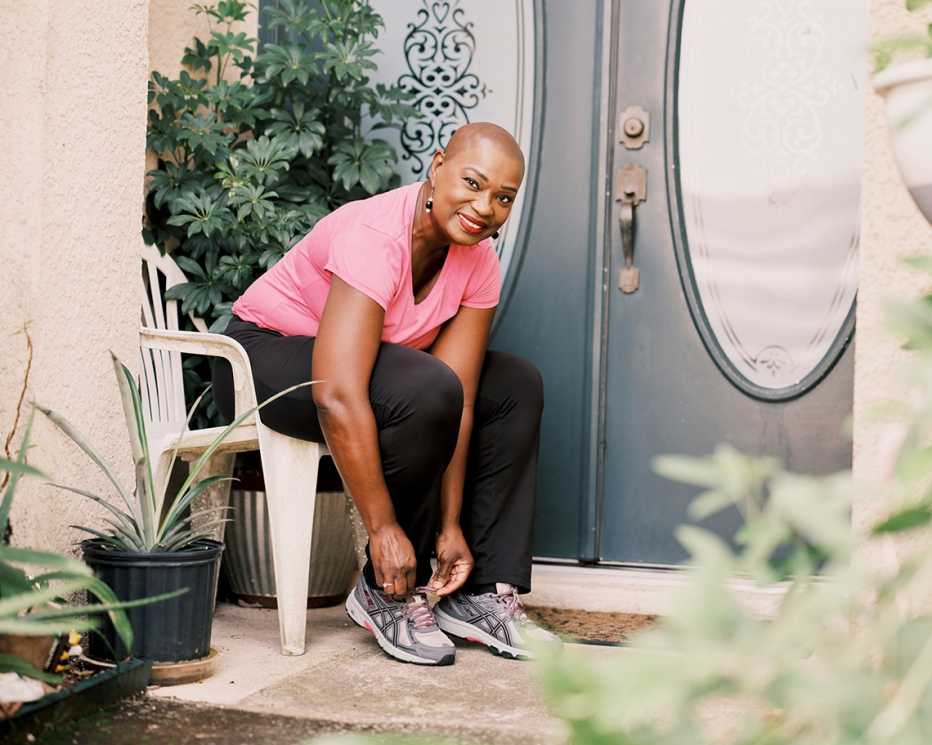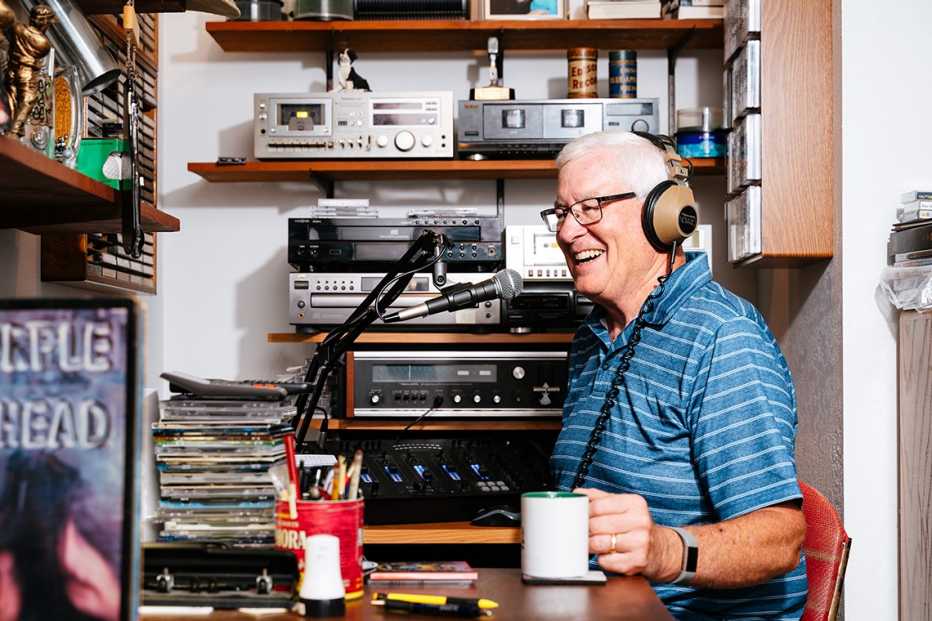Staying Fit


Angela Alexander could barely hold a paintbrush anymore.
The joint pain from rheumatoid arthritis had made pursuing her passion too painful. Then one night, she picked up a big brush and turned to her easel, determined to work — agony be damned.
AARP The Magazine Special Edition
AARP takes a look at how aging has evolved and improved over the decades — and how it likely will change in the years ahead.
“This painting came out of me that wasn’t like anything I’d painted before,” she says. “Looser strokes. New colors. It’s taken me to a whole new level.”
Alexander, 50, of Asheville, North Carolina, paints exuberant, insightful portraits of animals — from family pets to wild bears. She has clients across the country, a studio and an exhibition space in a prominent local gallery in the River Arts District. To achieve this continuing success, she has learned to manage the fatigue and chronic pain of RA while also dealing with type 1 diabetes and its vision-threatening complication, diabetic macular edema.
“I take pain medications. I have an insulin pump. I’ve had eye injections. I do gentle exercise, get massages and go for walks with my dog, Ellie. I work with a team of doctors. And when I need to, I rest,” she says. “I’m blessed to have the tools I need. I want to always paint. It feeds my soul.”


Alexander’s pursuit of the life she loves is emblematic of a shift that’s radically redefining what “health” means for older adults with chronic conditions, a growing group that by 2020 had reached 71 million. Instead of the conventional “either/or” view of well-being — you’re either healthy or you’re sick — a surprisingly high percentage of older people reject the long-held notion that health is the absence of disease. We’re living life on our own terms: healthy and happy, with medical conditions.
The wellness paradox
“Healthy, with conditions” is the new norm for many midlife and older adults in the U.S. and around the world. In a large 2022 study of 21,503 older adults from Canada’s McMaster University, slightly more than half of the subjects had high blood pressure, 39 percent had arthritis and at least 20 percent had diabetes, muscle-and-joint problems and/or heart disease. Despite an average of three health problems per person, 58 percent rated their health as “very good” or “excellent.”
Even serious health drawbacks can’t seem to dampen our enthusiasm: When researchers from Baylor University’s Heart & Vascular Institute in Dallas did in-depth interviews in 2019 with 41 midlife and older adults, ages 57 to 77, living with life-changing medical issues such as kidney disease, COPD and/or heart failure, 81 percent said they were “very” or “pretty” happy. And in a 2022 AARP/National Geographic national poll, most midlife and older participants — from 2 out of 3 in their 50s to 8 in 10 in their 80s—had serious or chronic health conditions. Yet 77 to 83 percent gave their overall health top marks.
Indeed, survey respondents identified three factors that now define what we think of as “the good life”: physical mobility, mental acuity and social connections.
“Even if they have health issues, they’re really worried about: Can I still move? Am I still mentally sharp? Can I still connect with and see my family?” says Debra Whitman, chief public policy officer for AARP. As long as they have these three resources intact, respondents believed they could live happy and productive lives, with or without issues like diabetes or heart disease. “We heard in a variety of ways that the ability to be independent was important to people as they age,” Whitman says.
A kaleidoscope of factors fuels the “healthy with conditions” mindset — including an age-related boost in resilience and optimism, 21st-century medical advances, and a new openness about health challenges fostered in part by celebrities, politicians and social-media influencers celebrating their personal health journeys online and in the media. Wisdom and experience give midlife and older adults an edge here, too.
“You put things in perspective,” says cancer surgeon Elizabeth Shaughnessy, M.D., director of Cancer Survivorship & Supportive Services at University of Cincinnati Cancer Center and a breast cancer survivor. “There’s a certain amount of strength from dealing with past problems successfully.”
This “wellness paradox” doesn’t seem to be a matter of denial, or ignoring issues in order to feel better. Viewing our health in the positive can motivate us to take better care of ourselves, says social psychologist Jennifer Smith, assistant vice president and director of research at the Mather Institute, who studies resilience and well-being in older adults. It may even extend life, research suggests, by helping us come to terms with the reality of our health status.
Accepting a new normal
Three blocked coronary arteries and near-fatal cardiac arrest didn’t prompt Akil Taherbhai, M.D., a family doctor from Gadsden, Alabama, to change his personal health habits. But when his heart stents failed after five years, he faced up to a difficult truth: He had serious heart disease, and needed a bypass.
“I’m going to do a half-marathon in a year’s time,” he blurted out to nurses as he was wheeled into the operating room at age 61.
“I don’t know why I said this,” says Taherbhai, now 75, who has run three full marathons, two triathlons, climbed Mt. Kilimanjaro and jumped out of an airplane in the years since the procedure. He has also become a heart-health advocate, sharing his story with local and national groups. “Subconsciously, I knew I had two choices left; either continue this horrific end-of-life journey or make a concentrated, conscious effort to lead my life with purpose and productivity.”
The first step? Acknowledging he’d inherited his mother’s family’s genetic heart risks.
“My mother and my sister died from heart disease and kidney disease. My brother had a fatal stroke at age 52,” he says. “There’s high blood pressure, high cholesterol, diabetes and obesity.” Taherbhai switched to a plant-based diet, with help from his wife, Nafisa, a vegetarian. She also showed him how to meditate. It was a stretch for Taherbhai, who was used to working 10-hour days for months on end in his medical practice.


“I had a Type A personality, everything under control,” he says. “Meditation is just being in the now. What it’s done is help me listen more to my patients and to talk to my family and friends rather than emailing and texting. Your mind can take your body to places you’ve never heard of.”
Getting older may have helped Taherbhai out as well. Research shows that optimism and resilience — the ability to bounce back quickly from a setback — increase with age. In a Penn State study of 3,493 adults ages 25 to 74, the oldest participants were up to five times more likely than the youngest to have serious health conditions. Yet they were the happiest — and least likely to feel sad or hopeless — no matter how many conditions they had.
“With aging and life experience we simply learn we can persevere,” says clinical psychologist Kristin Kleppe, founder of Orange County Health Psychologists in Irvine, California, whose specialties include aging and chronic conditions. “We just need to get up, dust ourselves off and keep on moving. We learn not to fear failure.”
Still, accepting that you have a chronic health condition and need treatment isn’t always easy, Kleppe notes. “It has to be done with a good dose of self-compassion.”
Same goes for the inevitable setbacks along the way.
“I have gone through this journey, sitting with folks who worked so hard to hit a certain number (on a medical test) and then it doesn’t happen,” Kleppe says. “This can feel defeating, but it comes back to perseverance and resilience. Seeing it as an obstacle, not a failure. Going back to your plan with a whole lot of compassion.”
That’s Taherbhai’s approach. While considering his options for treating his ongoing heart issues, he was busy doing what he loves — planning new speaking engagements, including at the annual meeting of the National Health Association. And making time with Nafisa to tend the purple peppers, tomatoes and squash in their sprawling backyard garden.








































































More From The Age Issue
'AARP The Magazine' Age Issue: A Digital Only, Bonus Edition
To mark our 65th birthday, AARP is publishing an extra, digital-only edition of 'AARP The Magazine'
7 Super Secrets of the Super Agers
Psst: Here’s what you need to do to ensure you have a chance at super aging
Celebrating What's Right With Aging: Inside the Minds of Super Agers
Some people in their 80s and 90s show shockingly little decline in their brainpower